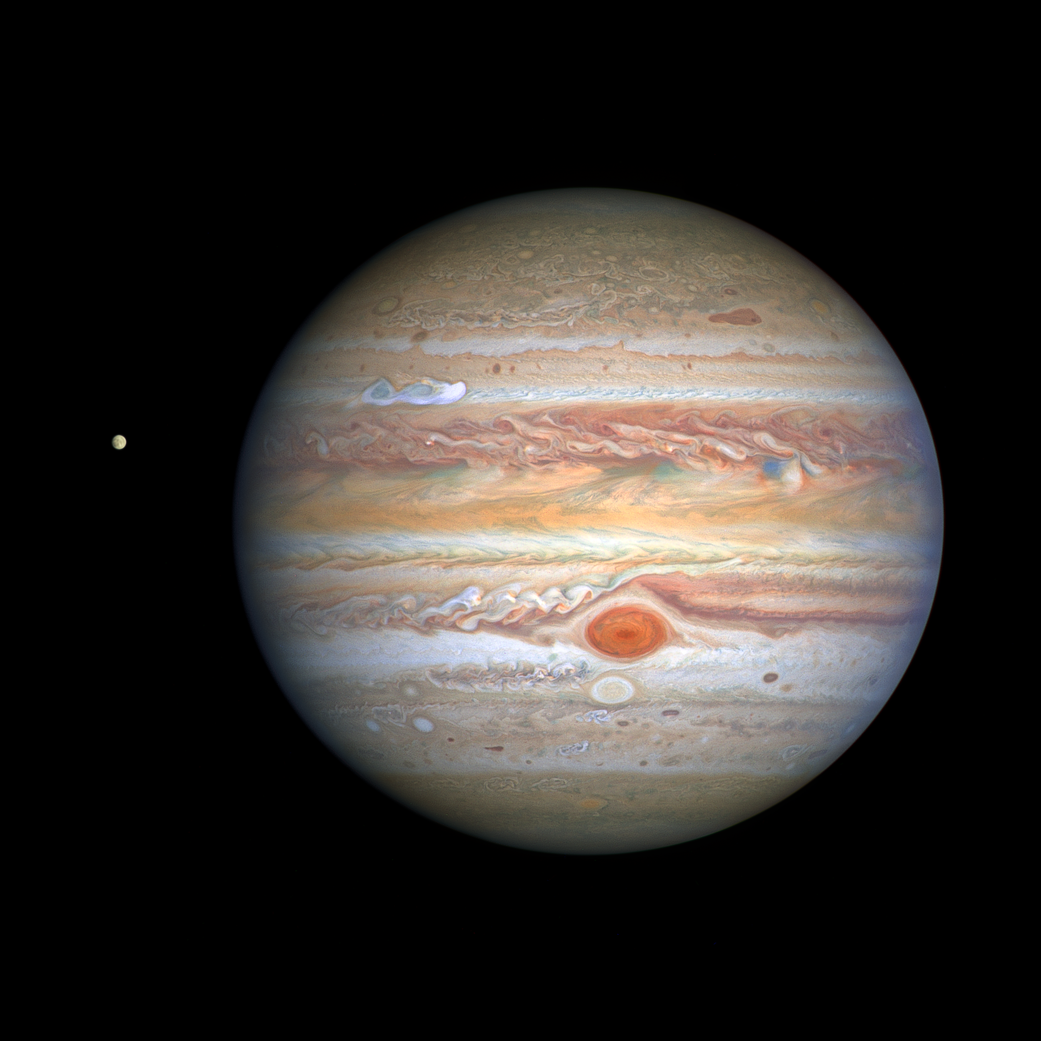This latest image of Jupiter, taken by NASA’s Hubble Space Telescope on Aug. 25, 2020, was captured when the planet was 406 million miles from Earth. Hubble’s sharp view is giving researchers an updated weather report on the monster planet’s turbulent atmosphere, including a remarkable new storm brewing, and a cousin of the famous Great Red Spot region gearing up to change color – again.
A unique and exciting detail of Hubble’s snapshot appears at mid-northern latitudes as a bright, white, stretched-out storm traveling around the planet at 350 miles per hour (560 kilometers per hour). This single plume erupted on Aug. 18, 2020 – and ground-based observers have discovered two more that appeared later at the same latitude.
While it’s common for storms to pop up in this region every six years or so, often with multiple storms at once, the timing of the Hubble observations is perfect for showing the structure in the wake of the disturbance, during the early stages of its evolution. Trailing behind the plume are small, rounded features with complex “red, white, and blue” colors in Hubble’s ultraviolet, visible, and near-infrared light image. Such discrete features typically dissipate on Jupiter, leaving behind only changes in cloud colors and wind speeds, but a similar storm on Saturn led to a long-lasting vortex. The differences in the aftermaths of Jupiter and Saturn storms may be related to the contrasting water abundances in their atmospheres, since water vapor may govern the massive amount of stored-up energy that can be released by these storm eruptions.
Hubble shows that the Great Red Spot, rolling counterclockwise in the planet’s southern hemisphere, is plowing into the clouds ahead of it, forming a cascade of white and beige ribbons. The Great Red Spot is currently an exceptionally rich red color, with its core and outermost band appearing deeper red.
Researchers say the Great Red Spot now measures about 9,800 miles across, big enough to swallow Earth. The super-storm is still shrinking as noted in telescopic observations dating back to 1930, but the reason for its dwindling size is a complete mystery.
Another feature researchers are noticing has changed is Oval BA, nicknamed by astronomers as Red Spot Jr., which appears just below the Great Red Spot in this image. For the past few years, Red Spot Jr. has been fading in color to its original shade of white after appearing red in 2006. However, now the core of this storm appears to be darkening slightly. This could hint that Red Spot Jr. is on its way to turning to a color more similar to its cousin once again.
Hubble’s image shows that Jupiter is clearing out its higher altitude white clouds, especially along the planet’s equator, where an orangish hydrocarbon smog wraps around it.
The icy moon Europa, thought to hold potential ingredients for life, is visible to the left of the gas giant.
This Hubble image is part of yearly maps of the entire planet taken as part of the Outer Planets Atmospheres Legacy program, or OPAL. The program provides annual Hubble global views of the outer planets to look for changes in their storms, winds, and clouds.
The Hubble Space Telescope is a project of international cooperation between NASA and ESA (European Space Agency). NASA’s Goddard Space Flight Center in Greenbelt, Maryland, manages the telescope. The Space Telescope Science Institute (STScI) in Baltimore conducts Hubble science operations. STScI is operated for NASA by the Association of Universities for Research in Astronomy in Washington, D.C.
这张木星的最新照片是由NASA局的哈勃太空望远镜于2020年8月25日拍摄的,当时木星距离地球4.06亿英里。哈勃望远镜敏锐的视角为研究人员提供了一份关于这颗巨行星动荡大气的最新天气报告,其中包括一场引人注目的新风暴正在酝酿,以及著名的大红斑区域的一个表亲正准备再次改变颜色。
哈勃望远镜这张照片的一个独特而令人兴奋的细节出现在北纬中纬度地区,一个明亮的、白色的、伸展的风暴以350英里每小时(560公里每小时)的速度环绕木星。这一单一的烟羽爆发于2020年8月18日,而地面观测者发现了另外两个烟羽在同一纬度出现。
虽然这一地区每六年左右就会出现一次风暴,而且经常同时出现多个风暴,但哈勃望远镜观测的时机非常适合展示扰动后的结构,也适合展示其演化的早期阶段。在哈勃望远镜的紫外线、可见光和近红外光图像中,烟羽的后面是小而圆的特征,具有复杂的“红、白、蓝”颜色。这种离散的特征通常在木星上消散,只留下云的颜色和风速的变化,但在土星上类似的风暴导致了一个持久的涡旋。木星和土星风暴余波的差异可能与它们大气中含水量的差异有关,因为水汽可能控制着这些风暴爆发所释放的大量储存能量。
哈勃望远镜显示,这个在火星南半球逆时针旋转的大红斑正撞向它前面的云层,形成白色和米黄色的带状瀑布。大红斑目前呈现出异常丰富的红色,其核心和最外层带呈现出更深的红色。
研究人员称,现在的大红斑直径约为9800英里,大到足以吞噬地球。正如1930年望远镜观测到的那样,这个超级风暴仍在缩小,但其缩小的原因完全是个谜。
研究人员注意到的另一个变化是Oval BA,天文学家昵称它为小红斑,它出现在这张图片中的大红斑下方。在过去的几年里,小红斑已经从2006年的红色退色到最初的白色。然而,现在这场风暴的核心似乎正在略微变暗。这可能暗示着小红斑正在再次转向与它的表亲更相似的颜色。
哈勃望远镜的影像显示,木星正在清除高海拔的白云,尤其是沿着行星赤道的地方,那里散布着橙色的碳氢化合物烟雾。
在这颗气态巨星的左边,可以看到冰封的卫星木卫二,人们认为它可能含有生命的成分。
哈勃望远镜拍摄的这张照片是整个行星年度地图的一部分,是外行星大气层遗产计划(OPAL)的一部分。该项目每年向哈勃提供外部行星的全球视图,以观察它们的风暴、风和云的变化。
哈勃太空望远镜是NASA与ESA(欧洲航天局)之间国际合作的项目。 NASA位于马里兰州格林贝尔特的戈达德太空飞行中心负责管理该望远镜。位于巴尔的摩的太空望远镜科学研究所(STScI)负责哈勃的科学操作。STScI由位于华盛顿特区的天文学研究大学协会为NASA运营。







